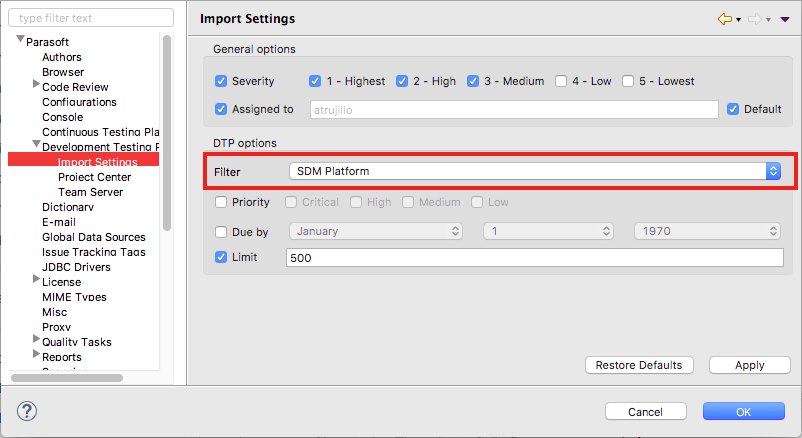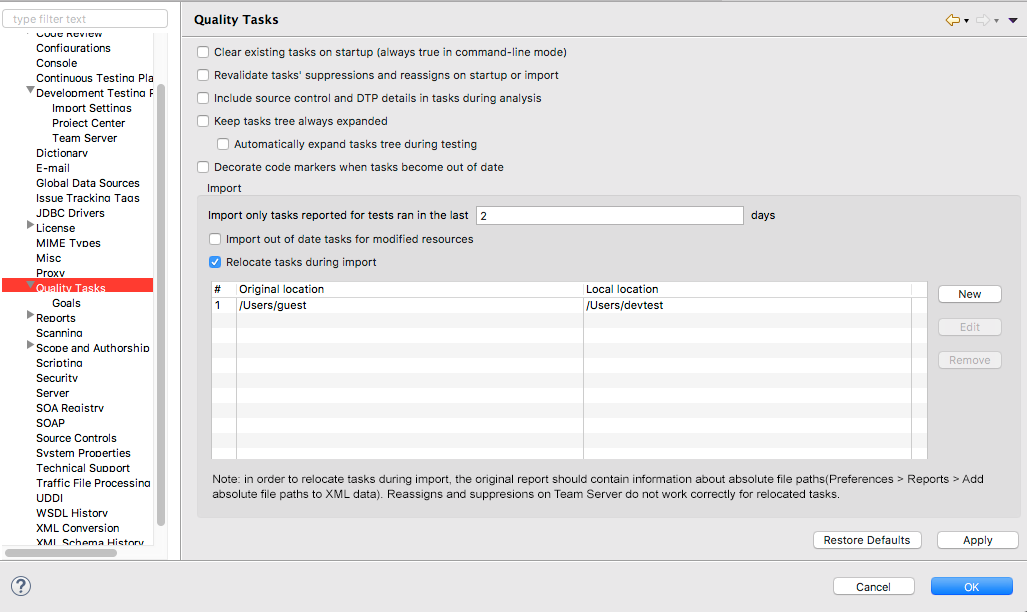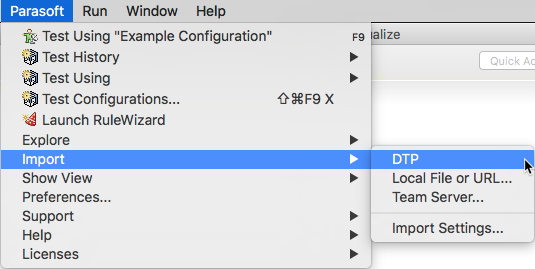This chapter describes how to import test data from DTP, an .xml report file, or from Team Server into your IDE. In this section:

Introduction
Importing test results enables each developer or tester to review his or her assigned tasks in the GUI and respond to them in the Quality Tasks view. If you cannot choose a filter from the filter configuration drop-down menu, verify that you have appropriate access in DTP (see "Project Creation and Configuration" in the DTP documentation for additional information).
Your tasks: The subset of all of your testing tasks that you are responsible for based on code authorship calculations, which are discussed in Configuring Task Assignment and Code Authorship Settings. - Recommended tasks: The subset of all of your testing tasks to review and address today based on the settings in the executed Test Configuration’s Goals tab.
Your recommended tasks: The subset of all of your testing tasks that you are responsible forbased on the designated authorship and task assignment settings defined as described in Configuring Task Assignment and Code Authorship Settings. Your recommended tasks also include testing tasks for you to review and address today based on the settings in the executed Test Configuration’s Goals tab.
|
When results are imported, test results are shown in the GUI as if the test were run in the GUI. After the import, you can drill down into results in the normal manner, double-click task messages to open and edit the related line of source code, use any applicable "Quick Fixes" to correct reported problems, and so forth.
You can import a specific category of tasks, tasks for specific goals, or all tasks. You can only import results for projects that are currently in your workbench. If the tested project files were modified in your workbench since the test was run, the results will not be reported because they might not correspond to your modified version of the project files.
Configuring DTP Filter
The filter must be configured in order to download findings from DTP (see Connecting to Parasoft Development Testing Platform).
- Choose Parasoft> Preferences to open the settings page.
- Choose Parasoft> Development Testing Platform> Import Settings.

- Choose a filter from the drop-down menu and configure any additional import settings. See the Development Testing Platform documentation for information about filter configuration options.
- Click Apply.
Configuring the Quality Tasks View
Prior to importing data from DTP, you should configure the Quality Tasks preferences so that only the test and analysis results relevant to you are imported. In the preferences panel, choose Parasoft> Preferences> Quality Tasks.

The following importing preferences are available:
- Import only tasks reported for tests ran in the last {n} days: Age in days of data imported from DTP or Team Server.
- Import out of date tasks for modified resources: Enable this option to import out-of-date tasks from all three import options (DTP, Team Server, XML file).
- Relocate tasks during import: Click New and specify a different location for the tasks on import the original location. This option works with all three import options (DTP, Team Server, XML file).
Importing Results
- Choose Parasoft> Import> DTP or Local File or URL... or Team Server...

If you choose DTP, the download will begin immediately.
If you choose Local File or URL..., you will be prompted to browse for the report XML file.
See Importing Results From Team Server into the GUI for information about importing data from Team Server.
- If the Quality Tasks view is not already open, choose Parasoft> Show View> Quality Tasks from the main menu to view the imported results.

If the imported findings are associated with a file that has been modified, a message appears specifying the file(s) that are out of sync. The markers associated with these findings (including the line numbers) may not match the location in the local resource files or may indicate findings that have already been resolved.
Findings associated with resources missing locally are not imported and the displayed message lists the files that are unavailable

Importing Results From Team Server into the GUI
Any team member whose SOAtest installation is connected to Team Server will be able to import the test results stored on Team Server. When results are imported, test results are shown in the GUI as if the test were run in the GUI. After the import, you can drill down into results in the normal manner, double-click task messages to open and edit the related line of source code, use any applicable "Quick Fixes" to correct reported problems, and so forth.
You can import a specific category of tasks, tasks for specific goals, or all tasks. You can only import results for projects that are currently in your workbench. If the tested project files were modified in your workbench since the test was run, the results will not be reported because they might not correspond to your modified version of the project files.
Note that the imported results are a static "snapshot" of the results at the time the test completed. They do not reflect changes were made since that test run (e.g., if tasks were reassigned or suppressed). If you want these updates to be propagated across the team, do one of the following:
- Rerun the tests to update the results stored on Team Server
- Enable the following setting on each connected team machine: Parasoft> Preferences> Quality Tasks> Revalidate tasks' suppressions and reassigns on startup or import.

By default, SOAtest is configured to import tasks from tests performed within the past 2 days. If your team doesn’t run tests frequently and you try to import tasks more than 2 days after the test has run, nothing will be imported—unless you change the default settings. To change the default test import settings: - Choose Parasoft> Preferences. The Preferences dialog will open.
- In the left pane, select Parasoft> Tasks.
- Modify the setting for Import only tasks reported for tests ran in the last n days.
|
Importing Your Recommended Tasks
To import your recommended tasks from Team Server:
- Choose Parasoft> Import> Team Server...
- Enable the Filtered option and choose recommended tasks.
- Configure the task types and click OK.
In determining which tasks to recommend, SOAtest considers:
- The severity of the issues reported (more severe violations are given priority).
- The time when the file was modified (more recent modifications are given priority because they will be fresh in the developer’s mind).
- Whether there are other issues reported for the same file (files with multiple violations are given priority because the developer will need to perform less testing this way — if you made 8 total corrections within 2 files, you would have to test only 2 files, but if you made 8 total corrections within 8 different file, you would have to test 8 files).
Importing All Your Tasks
To import your all your current tasks from Team Server:
- Choose Parasoft> Import> Team Server...
- Enable the All option and configure the task types you want to import.
- Click OK.
When importing results, SOAtest loads the latest report for each session tag and downloads the tasks related to files that are in open projects. The tag is set through the session tag setting — either in the GUI’s Preferences> Reporting page, or with the session.tag={name} in the local settings . For example, if you run static analysis standards and test execution separately on the same project, results for both runs will be imported as long as they have different session tags. If they have the same tag, only the results from the most recent run will be loaded — even when you choose the Import All Tasks option. |
Importing a Custom Set of Tasks
To import a custom set of tasks:
- Choose Parasoft> Import> Custom Tasks or choose Custom Tasks from the Import My Recommended Tasks pull-down toolbar menu.
- Specify where you want to import tasks from. Available options are:
- Import from Team Server: Imports tasks that were uploaded to Team Server (for example, after a batch mode test).
- Import from local file(s): Imports tasks from a results file that is accessible from your local file system.
3. Specify what type of tasks you want to import. Available options are:
4. Click OK.
Here’s an alternative way to import all tasks: - Choose Parasoft> Explore> Team Server. The Browsing dialog will open.
- Open the Reports tab of the Browsing dialog.
- Select the XML report whose results you want to import, then click the Import Results button.
|
Accessing Team Server Reports through the GUI
Any team member whose SOAtest installation is connected to Team Server will be able to view and download the report files that are available on Team Server.
To download a report file:
- Choose Parasoft> Explore> Team Server. The Browsing dialog will open.
- Open the Reports tab of the Browsing dialog. Reports will be organized according to the date when they were generated.
- Do one of the following:
- To view a report, select the report that you want to view, then click the View button. The report will open in a Web browser.
- To download a report, select the report that you want to download, then click the Download button. A file chooser will open. Specify a location for the downloaded report, then click Save. The report file will then be downloaded to the specified location.
If you want to delete reports stored on Team Server (for example, if you want to clear all old reports from Team Server or remove the report for a failed test run): - Choose Parasoft> Explore> Team Server. The Browsing dialog will open.
- Open the Reports tab of the Browsing dialog.
- Select the XML report whose results you want to delete, then click the Delete button.
- If you want to keep the related test data on Team Server (e.g., if you are cleaning out old reports, but you still want data from these tests used for graphs that show historical trends), enable Keep summary data for report graphs.
|
Accessing Team Server Reports through a Web Browser
Any team member who can access the Team Server’s Web server can directly browse to the report files that are available on Team Server. This allows team members to access reports outside of the GUI. Moreover, in the reports available on Team Server, all links (for instance, links to Category) are active. All links are not active in emailed reports.
To directly access a report available on Team Server:
- Choose Parasoft> Explore> Team Server Reports in the GUI.
Accessing Results through Parasoft Report Center
To access Parasoft Report Center reports based on information from tests and other sources:
Choose Parasoft> Explore> Report Center Reports or open the reports as described in your Parasoft Report Center User’s Guide.





